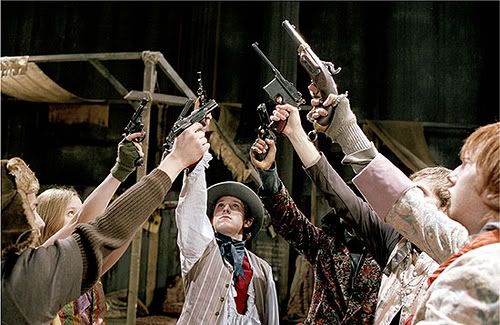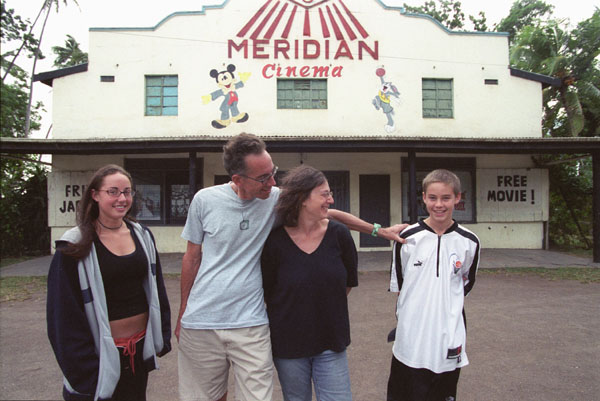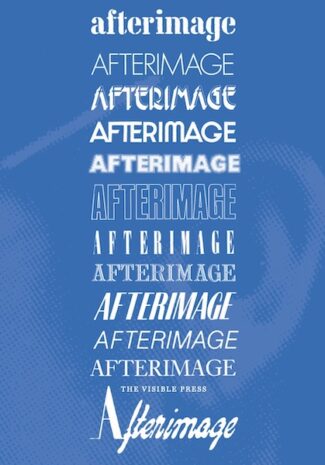From the Chicago Reader (September 23, 2005).– J.R.
Dear Wendy
* (Has redeeming facet)
Directed by Thomas Vinterberg
Written by Lars von Trier
With Jamie Bell, Bill Pullman, Alison Pill, Danso Gordon, Michael Angarano, Novello Nelson, Chris Owen, and Mark Webber
Reel Paradise
** (Worth seeing)
Directed by Steve James
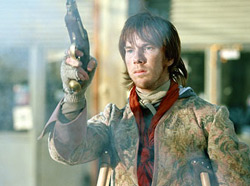
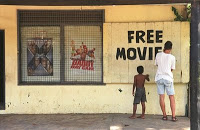
Two new releases are defined by an inability to fathom another culture — Reel Paradise, a U.S. documentary about an American spending a year in the South Pacific with his family, and Dear Wendy, a Danish feature with English dialogue that was shot in rural Denmark and Germany but is set in a poor mining town in the American southeast. Both demonstrate a middle-class complacency that fosters this inadequacy.
The acknowledged subject of Dear Wendy, written by Lars von Trier and directed by Thomas Vinterberg, is the American obsession with guns and violence. “Wendy” is a small handgun that’s addressed, fondled, and ultimately used by the young narrator-hero played by Jamie Bell (Billy Elliot), who prides himself on being a pacifist even after he starts a gun club, the Dandies. Like the other misfits in the club, he claims to be interested only in target practice, but when they wind up in a bloody shoot-out with the police (among them Bill Pullman) we aren’t the least bit surprised. Read more
From the Chicago Reader (June 21, 1991). — J.R.
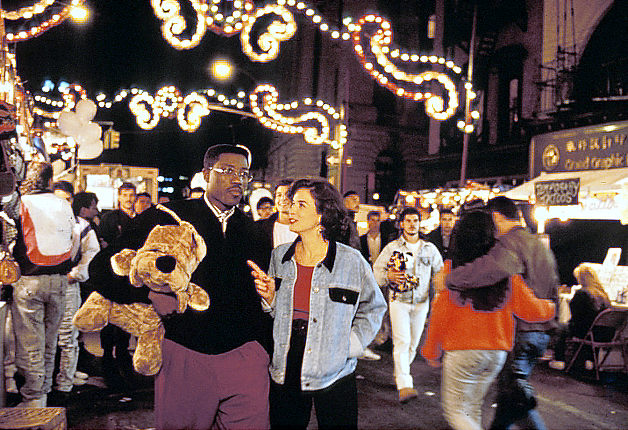
JUNGLE FEVER
**** (Masterpiece)
Directed and written by Spike Lee
With Wesley Snipes, Annabella Sciorra, Spike Lee, Samuel L. Jackson, Ossie Davis, Ruby Dee, Lonette McKee, John Turturro, Frank Vincent, and Anthony Quinn.
Trusting to luck means listening to voices. — Jean-Luc Godard in the 1960s
Compared to Do the Right Thing, Spike Lee’s Jungle Fever is inspired overreaching, an exciting mess — and conceivably even more important. If the earlier movie somehow marshaled its sprawling elements into a single story in a single setting with a single theme, this one has two settings (Harlem and Bensonhurst), three plot lines, and at least four themes (interracial romance, breaking away from one’s family, crack addiction, and corporate advancement for blacks), all of which are crammed together more willfully than logically, yielding a misshapen story that is neither singular nor plural in focus, but somewhere obscurely in between.
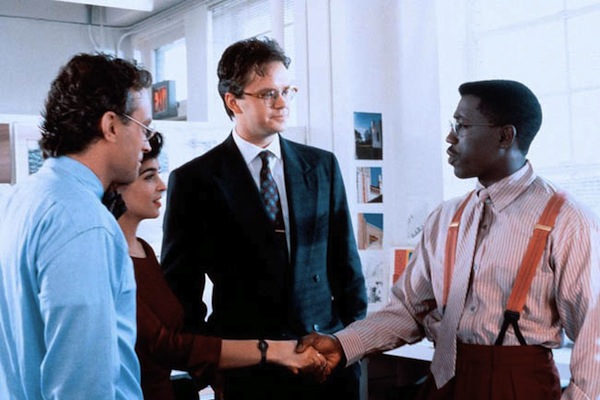
First plot: Flipper (Wesley Snipes), an upscale Afro-American architect with a wife and daughter living in Harlem, starts an affair with his new temp secretary, Angie (Annabella Sciorra), a single Italian American who lives with her working-class father and brothers in Bensonhurst. Flipper tells his best friend Cyrus (Spike Lee), who tells his wife (Veronica Webb), who tells Flipper’s wife, Drew (Lonette McKee), who responds by throwing Flipper out. Read more
I no longer recall who asked me to write this or why, but I estimate that I must have written it in late 1997 or early 1998, and probably for some foreign publication. I’m happy to see that much of what I wrote, especially about the Times, is now out of date. — J.R.
The New York Film Festival is held every fall, usually in late September and early October. Unlike every other major film festival that comes to mind, it features relatively few programs, less than thirty — a concentration that allows the festival to give more of its attention to each film it shows than many others do. (As a rule, every feature is accorded a press conference, and public dialogues with the filmmaker usually follow each screening.) This often means that many of the foreign and independent films that show at the festival have a more substantial commercial launching than most of those that don’t. (It’s different for Hollywood films, which already have enormous promotional budgets at their disposal. In fact, most mainstream American releases aren’t even submitted, in part because the studios are afraid that a New York Film Festival showing might handicap a movie with the stigma of “art film”.) Read more
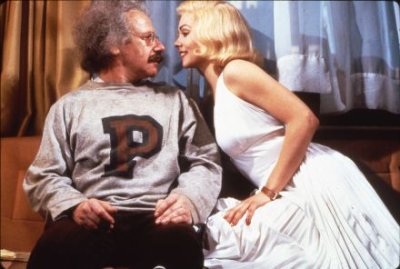
Nicolas Roeg’s 1985 film adaptation of Terry Johnson’s fanciful, satirical play — about Marilyn Monroe (Theresa Russell), Albert Einstein (Michael Emil), Joe DiMaggio (Gary Busey), and Senator Joseph McCarthy (Tony Curtis) converging in New York City in 1954 — has many detractors, but approached with the proper spirit, you may find it delightful and thought-provoking. The lead actors are all wonderful, but the key to the conceit involves not what the characters were actually like but their cliched media images, which the film essentially honors and builds upon. The Monroe-Einstein connection isn’t completely contrived. Monroe once expressed a sexual interest in him to Shelley Winters, and a signed photograph of Einstein was among her possessions when she died. But the film is less interested in literal history than in the various fantasies that these figures stimulate in our minds, and Roeg’s scattershot technique mixes the various elements into a very volatile cocktail — sexy, outrageous, and compulsively watchable. It’s a very English view of pop Americana, but an endearing one. (JR) Read more
From the Chicago Reader (April 7, 1995). — J.R.

Tank Girl
**
Directed by Rachel Talalay
Written by Tedi Sarafian
With Lori Petty, Malcolm McDowell, Naomi Watts, Ice-T, Don Harvey, Reg E. Cathey, Scott Coffey, Jeff Kober, Iggy Pop, and Ann Cusack.
I wasn’t exactly encouraged by the opening sequences of Tank Girl, a spin-off of a British comic book with a postapocalyptic setting. The movie starts with a kind of music-video visual dribble, set to the pounding strains of Devo’s “Girl U Want,” a song whose chanting refrain (“She’s just a girl — the girl you want”) seems to promise the kind of machocentric SF soft-core porn dished out by Barbarella 27 years ago. I’d been prepared for a steady influx of contemporary rock and rap and the concomitant collapse of any believable vision of the future, but this particular anthem seemed designed to cater only to guys. My expectations were raised, however, by the first appearance of Lori Petty, in the title role of Rebecca Buck — a hard-nosed renegade punk who clearly wouldn’t let herself be palmed off as a bimbo. But Kesslee, the movie’s arch-villain (played by the original movie punk, Malcolm McDowell), brought me back to the facetious S and M rhetoric of the glib and cutesy Barbarella. Read more
From the Chicago Reader (December 3, 1993). — J.R.

THE PUPPET MASTER **** (Masterpiece)
Directed by Hou Hsiao-hsien
Written by Wu Nien-jen, Chu Tien-wen, and Li Tien-lu
With Li Tien-lu, Lin Chung, Cheng Kuei-chung, Cho Ju-wei, Hung Liu, and Bai Ming-hwa
Let’s start with three central and related facts, the first about Taiwan, the second about Taiwanese cinema, and the third about us. (1) Until six years ago, Taiwan spent this whole century under martial law, and over three previous centuries it suffered from nearly continuous occupation — by the Dutch in the 17th century and the Manchus in the 17th, 18th, and 19th centuries. In 1895 it was ceded to Japan as one of the spoils of the Sino-Japanese war, and it remained a Japanese colony for the next half century, until the Japanese surrender at the end of World War II. At this point mainland China took control; but four years later, when the communists seized the mainland, the deposed Kuomintang, led by Chiang Kai-shek, shifted their base to Taiwan — claiming that their rule was only temporary, until they could wrest the mainland back from the communists. But as it turned out they remained in power until 1987, when Taiwan finally became a democracy. Read more
Written for Cineaste Vol. XLVIII, No. 2 but published online due to space limitations . –J.R.
Edited by Mark Webber. London: The Visible Press, 2022. 349 pp., illus. Hardcover: $60.
I can think of at least three reasons why the independent British film journal Afterimage (1970-1987) isn’t better known in the U.S.: 1. It shares the name of a still-existing U.S. bimonthly devoted to digital media, 2. It only lasted for thirteen issues, and 3. Although it was supported by state funding, like the far better-known Screen, its nature and its influence were (and still are) far less institutional.
The third reason requires some elucidation. The seventeen years of Afterimage’s existence corresponded fairly closely to the founding of academic film studies in both the U.S. and the U.K. Screen sprang from the British Film Institute’s Education Department during the same period, and its pedagogical mission has always been inseparable from its institutional armor, including its dull boiler-plate design and the virtual equation of the positioning of its armchair Marxism with institutional protection. Afterimage was far more independent, exploratory, and eclectic, stemming largely from the passions of a single individual, Simon Field (seven of whose editorials are included, along with his interview with Hollis Frampton) and shifting its focus and aspects of its design with each successive issue. Read more
I can’t easily find words to express my admiration for Bruce Ricker, whom I just learned from a New York Times obituary died last Friday of pneumonia, at age 68. He wasn’t only a man who distributed jazz documentaries and made a few of his own, all of them terrific (including a wonderful tribute to Brubeck, In His Own Sweet Way, which made my ten-best list last year), and who also played what I’m sure was incalculable role in advising Clint Eastwood in his multiple jazz ventures. He was also a lawyer, the literary executor of Seymour Krim, and an amazing human being. I already miss him, and cherish my memories of him. [5/19/11]
Read more
From the Chicago Reader (May 19, 1989). — J.R.
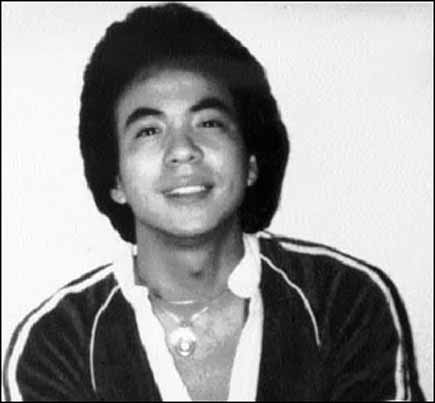
WHO KILLED VINCENT CHIN?
** (Worth seeing)
Directed by Christine Choy.
Item: The December 22, 1941, issue of Life magazine features a two-page spread headlined “How to Tell Japs From the Chinese: Angry Citizens Victimize Allies With Emotional Outburst at Enemy.” It begins: “In the first discharge of emotions touched off by the Japanese assaults on their nation, U.S. citizens have been demonstrating a distressing ignorance on the delicate question of how to tell a Chinese from a Jap. Innocent victims in cities all over the country are many of the 75,000 U.S. Chinese whose homeland is our stanch ally. So serious were the consequences threatened, that the Chinese consulates last week prepared to tag their nationals with identification buttons. To dispel some of this confusion, Life here adduces a rule-of-thumb from the anthropometric conformations that distinguish friendly Chinese from enemy alien Japs.” Around this text and the two paragraphs that follow are four large photographs with inscriptions that attempt to spell out distinguishing characteristics of Chinese and Japanese physiognomies and body types.
Item: In 1982 in Highland Park, Michigan, Vincent Chin, a 27-year-old Chinese auto engineer, got into a fight with Ronald Ebens, a somewhat older Caucasian autoworker, in a topless bar called the Fancy Pants. Read more



